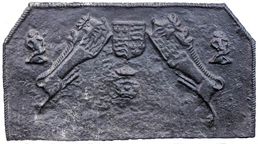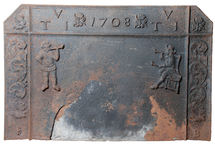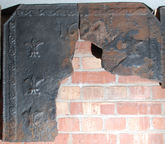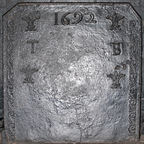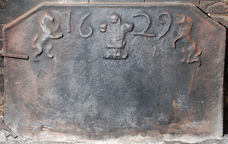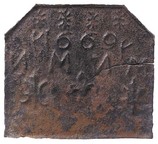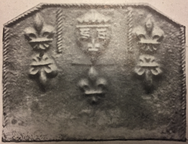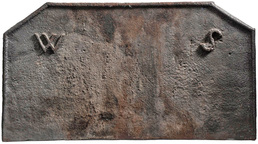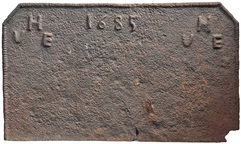-
125
Description: Canted rectangle; twisted rope edging (top and sides); top centre, Tudor royal shield between lion passant guardant to right and lion passant guardant sinister to left, both diagonally placed; below, a crowned rose; to left and right, an 'imp' with arms down, facing left.
Notes: One of a large series incorporating royal heraldic stamps. Canterbury Auction Galleries sale, 29 Nov 2017, lot 939 (£300). Copies of this fireback were advertised in Bratt Colbran Ltd.'s (London) catalogue in the early-20th century.
Copies of this fireback are known.
Arms: Tudor royal arms of England
- Decoration tags:
- rectangular with canted top corners (shape)
- rope (edging)
- carved stamps
- heraldic
- armorial
- animals
- humans
Manufactured: in the mid-16th century in the Weald area of England.
Current location: not known.
Citation: Lloyd, N., 1925, 'Domestic Ironwork I', Architectural Review, 58, pp. 58-67.
- Attached to series:
- Royal series
-
225
Description: Canted rectangle; cavetto moulded edging (top and sides); single horizontal fillet below canted corners and vertical fillet parallel to each side, dividing the fireback into two side panels, two top corner panels, top panel and main central panel; corner panels, ‘daisy’ plant stamp; top panel, date between ‘daisy’ stamps, between initials in triad at each end; side panels, swirling foliage stamp repeated each side above initials, I to left, B to right; centre panel, stamp of ‘Indian’ smoking a pipe at top left, stamp of seated ‘gentleman’ smoking a pipe and holding another, at top right.
Notes: The 'daisy' stamp and the IB initials are identical to those on similar firebacks dated between 1703 and 1721, and probably indicating the same founder. The use of stamps relating to tobacco smoking may suggest an origin near Bristol, the main entry port for the tobacco trade at that time. Formerly at Lilly Hall, Ledbury, Herefordshire.
Inscription: TVI [triad] 1708 TVI [triad] / I B
- Decoration tags:
- rectangular with canted top corners (shape)
- cavetto (edging)
- carved stamps
- individual letters
- individual numbers
- text
- humans
- plants
Manufactured: in 1708 in the Forest of Dean area of England.
Current location: National History Museum, St Fagans, Glamorgan, Wales.
Museum number: 13.90/2 (part of the Welsh National History Museum museum group)
- Attached to series:
- IB series
-
235
Description: Fragment; canted rectangle; twisted rope edging (top and sides); repeated scroll strip stamp along each side; date, top centre; a fleur-de-lys stamp repeated three times vertically down left side, probably mirrored on right side (top fleur visible).
Notes: Use of the same stamps indicates a common source with a variant dated 1692 (see Fireback no. 237).
Inscription: 1694
- Decoration tags:
- rectangular with canted top corners (shape)
- rope (edging)
- simple stamps
- carved stamps
- individual numbers
- heraldic
- text
- objects
Manufactured: in 1694 possibly in the South Wales area of Wales.
Current location: National History Museum, St Fagans, Glamorgan, Wales.
Museum number: 61.49/3 (part of the Welsh National History Museum museum group)
- Attached to series:
- St Fagans series
- Fleur-de-lys firebacks
-
237
Description: Canted rectangle; twisted rope edging (top and sides); repeated scroll strip stamp along each side; date, top centre, between two fleurs de lys; initial below each fleur, with a fleur below each initial.
Notes: A damaged variant (see Fireback no. 235), probably with six fleurs, no initials, dated 1694, is also known. Formerly at Great House, Llanllowell, Monmouthshire.
Inscription: 1692 / T B
- Decoration tags:
- rectangular with canted top corners (shape)
- rope (edging)
- simple stamps
- carved stamps
- individual letters
- individual numbers
- text
Manufactured: in 1692 possibly in the South Wales area of Wales.
Current location: St Fagans Castle, St Fagans, Glamorgan, Wales.
Museum number: 42.82 (part of the Welsh National History Museum museum group)
- Attached to series:
- St Fagans series
-
244
Description: Canted rectangle; twisted rope edging (top and sides); stamp of three ostrich feathers within a coronet, between the two parts of the date, with lion and unicorn supporters outside date.
Notes: The ostrich feathers are the badge of the Prince of Wales. There is no known significance of the year 1629 with that title, the birth of the prince (later Charles II) being in the following year. The date was probably added to a recasting of the plate. The lack of detail in the modelling indicates this has been recast several times.
Copies of this fireback are known.
Inscription: 16 29
- Decoration tags:
- rectangular with canted top corners (shape)
- rope (edging)
- carved stamps
- individual numbers
- heraldic
- text
- animals
Manufactured: in 1629 in the Weald area of England.
Current location: in private hands, Chailey, East Sussex, England.
Citation: Lloyd, N., 1925, 'Domestic Ironwork I', Architectural Review, 58, pp. 58-67.
- Attached to series:
- Prince of Wales' feathers series
- Prince of Wales firebacks
-
1034
Description: Canted rectangular shape; twisted rope edging in short lengths (top and sides); shield stamp with rebated edges repeated five times (two and three).
Notes: The arms are those of Courthope of Whiligh in Ticehurst; blazon: argent, a fess azure between three estoiles sable (two and one). Shown are molets of six points which have straight rays instead of (properly) estoiles which have wavy ones. However, the 1643/4 iron graveslab of David Barham of Snape, in Wadhurst church, has the same arms (also with molets instead of estoiles), which were those of his mother who was a Courthope.
Arms: Courthope, of Whiligh in Ticehurst
- Decoration tags:
- rectangular with canted top corners (shape)
- rope (edging)
- carved stamps
- heraldic
- armorial
Manufactured: in the late-16th to early-17th century in the Weald area of England.
Current location: Fulham, London, England.
- Attached to series:
- Personal armorial firebacks
- Courthope arms series
-
845
Description: Canted rectangle; ovolo-moulded edging (top and sides); from top: double star stamp repeated four times; date between two triads of the same initials, the 'Y' and the 'N' reversed; stylised fleur-de-lys below each pair of initials, with a large hollow fleur-de-lys in the centre.
Notes: The initials 'NYM' in triad probably relate to a couple whose surname initial was 'Y'; a fireback, dated 1659, with some of the same stamps is at the Dean Heritage Centre, Soudley, Gloucestershire, and another, dated 1667, has been noted at Upper End Farm, Hope Mansell, Herefordshire. Christie's auction, 24 May 2001.
Inscription: NYM [triad] 1669 NYM [triad]
- Decoration tags:
- rectangular with canted top corners (shape)
- ovolo (edging)
- carved stamps
- individual letters
- individual numbers
- heraldic
- text
- objects
Manufactured: in 1669 in the Forest of Dean area of England.
Current location: not known.
- Attached to series:
- Hollow fleur Dean series
- Newent area group
- Fleur-de-lys firebacks
-
1197
Description: Canted rectangular shape; twisted rope edging (top and sides); top centre, over-pressed crowned shield stamp on a rectangular block, bearing initials KH in Lombardic lettering, above a fleur de lys, the whole between two short vertical lengths of twisted rope, on the outside of each are two fleurs-de-lys, vertically aligned, the lower ones inverted; below the shield, a fifth fleur-de-lys.
Notes: An arrangement of stamps found on a distinctive series of Tudor firebacks of probable Henrician date. Illustration from Christy 1908, who noted it at Riverhall, Wadhurst, Sussex.
- Decoration tags:
- rectangular with canted top corners (shape)
- rope (edging)
- carved stamps
- heraldic
Manufactured: in the mid-16th century in the Weald area of England.
Current location: not known.
- Attached to series:
- Royal series
-
1124
Description: Canted rectangular shape; twisted rope edging (top and sides); initial in each top corner, the S angled to the right.
Notes: Initial letters are in high relief. The Pedestal Auction, Cirencester, 4 Mar 2019, lot 155 (£240).
Inscription: W S
- Decoration tags:
- rectangular with canted top corners (shape)
- rope (edging)
- carved stamps
- individual letters
- text
Manufactured: in the 17th century in England.
Current location: not known.
- Attached to series:
- Initials only firebacks
-
1125
Description: Canted rectangular shape; twisted rope edging (top and sides); date top centre; initials in triad in each corner.
Notes: Damage to bottom right corner. The Pedestal Auction, Cirencester, 4 Mar 2019, lot 154 (£240).
Inscription: VHE [triad] 1685 VHE [triad]
- Decoration tags:
- rectangular with canted top corners (shape)
- rope (edging)
- individual letters
- individual numbers
- text
Manufactured: in 1685 in England.
Current location: not known.
- Attached to series:
- Date & initials firebacks
